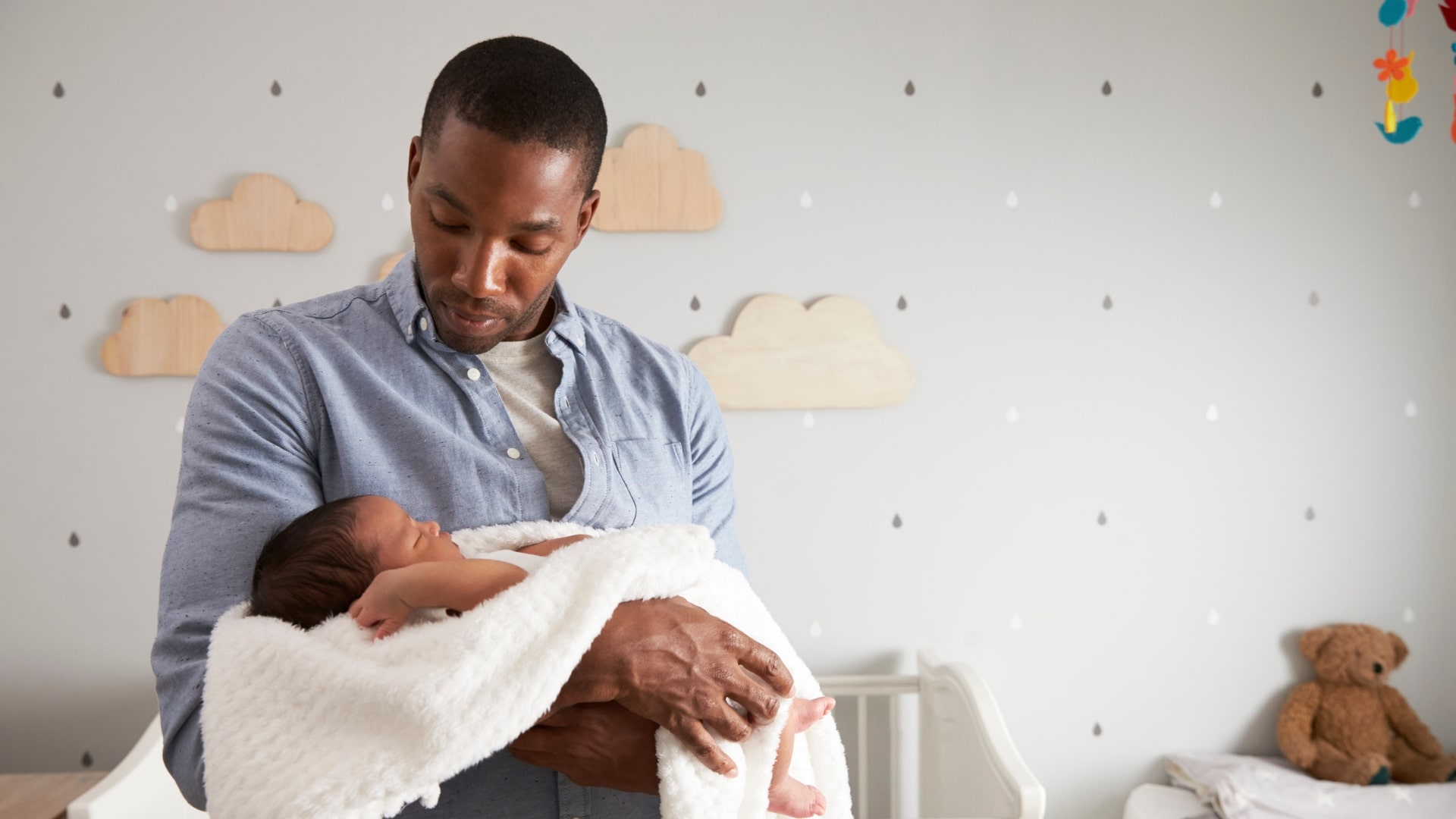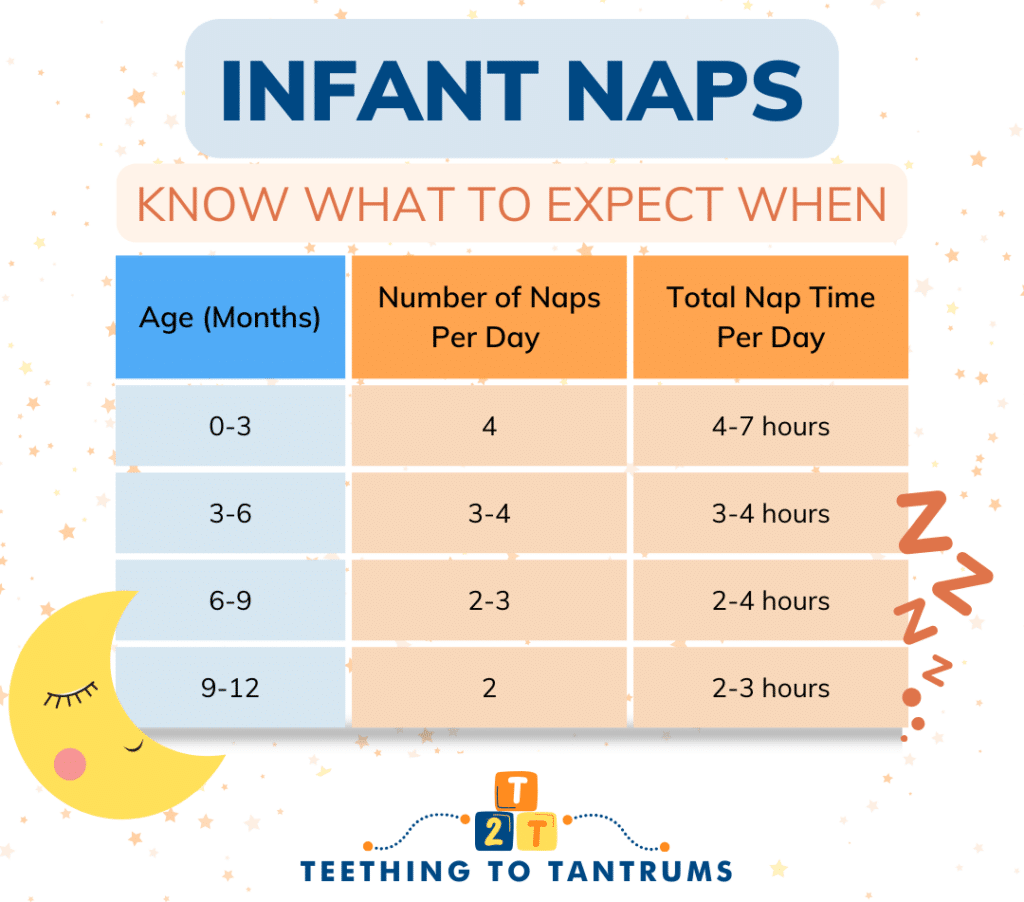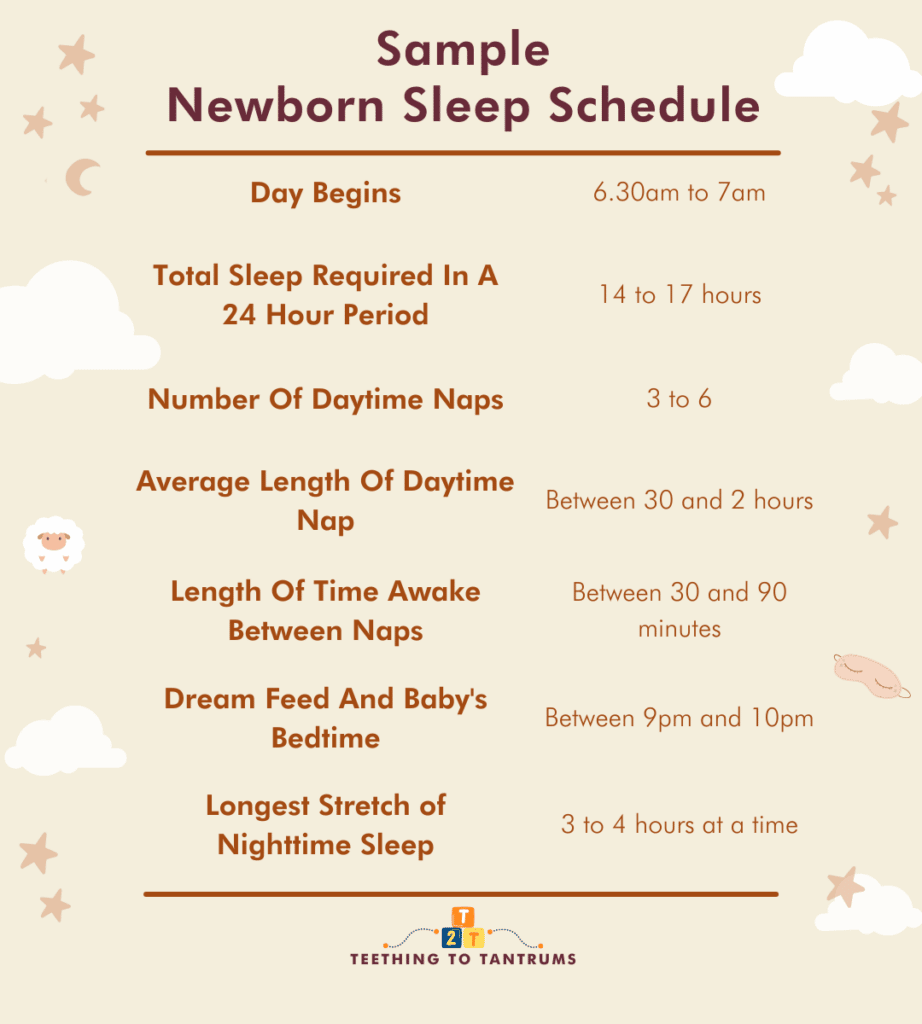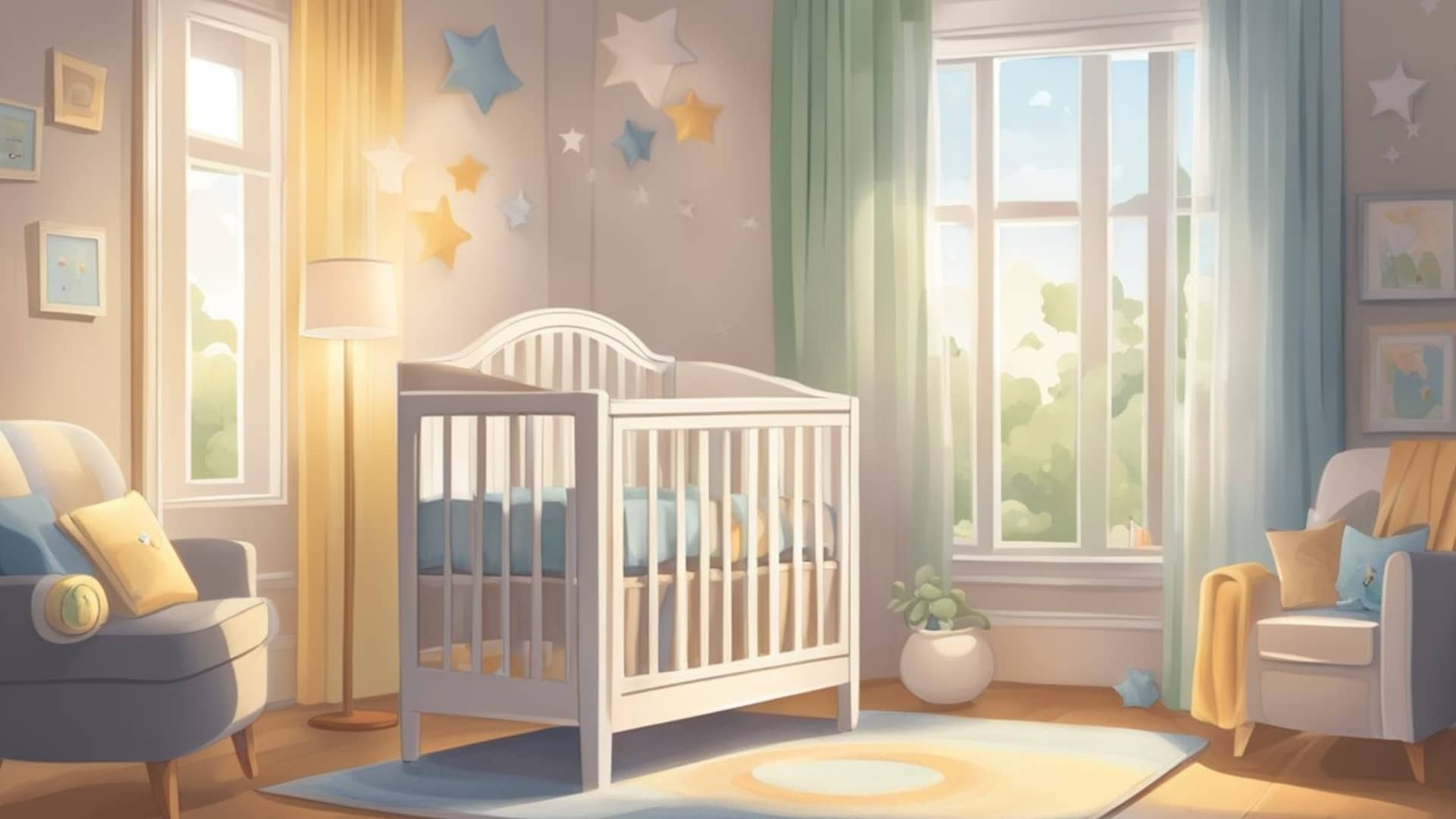As a Norland Nanny, I’ve looked after numerous babies. And I know all too well how important establishing a consistent nap routine is.
I also know how tricky it can be to get infant naps right… especially when every baby is different.
Thankfully, I trained as a night nanny and after 40+ years of experience, I have learned exactly how to handle the sleep needs of young children.
So if you want to learn how to create a regular nap schedule that works for your family and help your baby get the sleep they need to grow and develop… you’re in the right place.

Table of Contents
Key Takeaways
- Newborns can sleep up to 17 hours a day, but as they grow, their sleep schedule will change and your infant will naturally have longer wake windows, and need fewer naps and more nighttime sleep.
- Creating a regular nap schedule will help your baby get the sleep they need and prevent them from becoming overtired. Depending on your baby’s age you should aim for two to four naps a day, spaced out evenly throughout the day.
- Always pay attention to your baby’s sleep cues, such as rubbing their eyes or yawning, and respond accordingly.
How Many Naps A Day Does An Infant Need?
An infant is also known as a newborn.
And as newborns need around 14-17 hours of sleep in 24 hours, including between 4 to 6 naps per day… Infants need around 14-17 hours of sleep in 24 hours, including between 4 to 6 naps per day.
As your baby grows, they will need fewer naps and more consolidated sleep at night.
Here are some general guidelines for how many naps a day your baby needs based on their age:

REMEMBER: These naps are guidelines and your baby’s individual sleep needs may vary from these. The most important thing is to establish a consistent nap schedule with a pre-nap routine and monitor baby’s sleep cues.
Infant Nap Schedule
Newborns typically sleep a lot and they will not yet have a regular sleep pattern as it will take them some time to adjust to life outside the womb.
And when baby is young, they will only have 30 to 90 minutes of awake time between their naps. This ensures that your baby has enough awake time during the day to meet their developmental milestones and to consume enough daytime calories to grow at a rapid rate.

Length And Frequency
Infants need a lot of sleep, between 14 and 17 hours per day. They will usually sleep in short bursts of 2-4 hours at a time over 24 hours both day and night.
It is important to let your baby sleep as much as they need to, as overtired babies can be difficult to settle.
Day-Night Confusion
Newborns don’t yet have a set nap schedule, but it’s a good idea to try to establish a sleep pattern. And you will find that most babies are more alert during the day and sleep more soundly and for longer at night.
However… It is very common for infants to have day-night confusion and be more alert at night than during the day.
In fact, I was one of those babies.
So to help with day and night confusion, you must make a difference between your day and night interactions.
- Keep night-time interactions with your baby low-key in a dimly lit room with minimal talking.
- By contrast, you must make baby’s daytime interactions interesting and stimulating!
Take a look at this post for more information on tackling day-night confusion and how to handle babies that fight sleep.
Looking to get your little one to sleep quickly and effortlessly? Check out my Bedtime and Nap Cheat Sheet and master the art of making daytime naps and bedtimes as seamless as possible.
A bedtime & nap cheat sheet so good your little one will ask you to put them to bed...
Laura Williams "This is a life saver! I'm so glad I downloaded your bedtime & nap cheat sheet. My little one actually asked me to put him to bed last night! Unbelievable! Thank you so much!"
Click Here For The FREE Cheat Sheet
How To Successfully Put Baby Down For A Nap During The Day
Putting your baby down for a nap can be a challenging task, but with the right strategies, it can become a smooth and easy process.
Here are some top tips to improve infant naps and ensure your baby has a safe and comfortable naptime experience.
1. Room Temperature And Swaddling
Make sure your infant’s sleeping environment is safe and comfortable. The ideal room temperature for a baby’s nap is between 68-72°F (20-22°C).
Dress your baby in lightweight clothing and a soft swaddle to help them feel secure and cozy. Swaddling can also prevent your baby from startling themselves awake.
For older babies, I would recommend a season-appropriate sleep sack.
Use this handy guide to know what to dress your baby in depending on the room’s temperature.
With soft, plush micro-fleece, this super soft swaddle wraps newborns in just the right amount of warmth. This sleep sack swaddle suits infants from birth to potentially 3 months, offering both comfort and safe sleep practices with its arm immobilization feature.
The innovative 3-way swaddling system adapts to a baby's sleep style, a crucial feature for those restless nights. Whether it's arms in, hands-to-face, or arms out, it grows with the baby's swaddling needs!
Meanwhile, the bottom zipper makes midnight diaper changes a breeze!
2. Using White Noise for Naps
White noise can be a helpful tool to soothe your baby and create a calming environment for naps. A white noise machine can block out distracting sounds and mimic the sounds your baby heard in the womb.
Place the machine at a safe distance from your baby’s head and set it to a volume that is no louder than a soft shower.
White noise machines are a game-changer for your little one's sleep and having one that plays all night is a must. With a long-lasting battery, this compact and stylish white noise machine contains 21 non-stop relaxing noises, which will lull your little one to sleep night after night, no matter where you are!
3. Ensuring Safety During Naps
It’s important to prioritize safety during your baby’s naptime. Always place your baby on their back to sleep to reduce the risk of Sudden Infant Death Syndrome (SIDS).
Make sure your baby’s sleeping area is free of any loose blankets, pillows, or stuffed animals that could pose a suffocation hazard.
4. Avoid Overstimulation Before Naps
The hardest part of having an infant is when family and friends come to visit… There are lots of cuddles and attention being put on baby which can easily overstimulate them before you put them down to sleep.
As hard as it can be, try your best to avoid activities before putting them to sleep and engage in low-energy activities like singing lullabies, reading a book and having gentle cuddles instead.
5. Ensure Baby Has Been Fed
Ensure your baby is full before they nap as hunger will wake your baby and could sabotage your attempts to establish a healthy sleep and infant nap schedule.
With this point, I will make you aware of a common sleep trap your baby may fall into…
Try not to let baby fall asleep when you feed them.
As lovely as it is, this is an unhealthy sleep association, that will derail your plans for baby to fall asleep independently as they grow up.
Instead, begin establishing a pre-nap routine after a feed, such as reading a book or singing a lullaby.
6. Act On Sleep Cues
The success of infant naps depends wholeheartedly on your ability to read and act on baby’s sleep cues.
Signs that your baby is ready for a nap include rubbing their eyes, pulling at their ears, or yawning. And act on these sleep cues as quickly as you can. To learn more about baby’s sleep cues, read this post.
7. Encourage Your Baby To Self-Settle
The earlier you establish a successful way of putting your baby down for a nap, the better. If you can, avoid rocking or feeding your baby to sleep and aim to put them down before they are fast asleep.
Teaching baby how to self-soothe is one of the most valuable skills you can give your little one. (It will also help to keep you sane as they grow up!)
In summary, creating a safe, comfortable sleeping environment for your baby and helping them to learn to fall asleep independently is key to a successful infant naptime routine.
Bedtime For An Infant
Although I am a great advocator of establishing a bedtime routine as early as possible, an infant is simply too young for a full bedtime schedule.
However…
The priorities with an infant’s sleep schedule are:
- Make a stark difference between the nighttime and daytime interactions
- Keep the sequence of events leading up to bedtime the same every night to establish strong sleep associations.
For an infant, I’d recommend bathing them at the end of the day followed by a soothing massage and swaddling them up for some quiet time together in a dimly lit room. You can then give them a feed and settle your baby down in their bassinet or Moses basket.
Frequently Asked Questions About Infant Naps
Looking for more information about infant naps? Look no further! Here are the most frequently asked questions answered just for you.
Q: How long should a 1-year-old nap?
A: At 1 year old, your baby should nap for 1-2 hours during the day. This can be split into one or two naps. It is important to follow your baby’s cues and establish a consistent nap schedule.
Q: How to get baby to nap longer than 30 minutes
A: To help your baby nap longer than 30 minutes, establish a consistent nap routine, create a calm and quiet environment, and make sure your baby is well-fed and comfortable. It may also help to use white noise or a pacifier.
Also, don’t rush in if your baby wakes early from a nap. Baby’s sleep cycles last for roughly 45 minutes so they will often wake 45 minutes into a nap. If you leave them for a short while they may fall asleep again by themselves.
Q: How long should infant naps be?
A: Infant naps should be 1-2 hours long, depending on the age of the baby. It is important to establish a consistent nap schedule and follow your baby’s cues for when they are tired.
Q: How long should newborns sleep for naps?
A: Newborns should sleep for 2-4 hours during the day, and wake up every 2-3 hours for feedings. It is important to establish a consistent sleep schedule and create a calm and quiet environment for naps.
Q: How long should a 2-month-old nap?
A: At 2 months old, your baby should nap for 3-5 hours during the day, split into 3-5 naps. Always follow your baby’s sleep cues to know when they are tired and ready to sleep.
Always remember that your baby will have its own needs concerning sleep. Follow the tips in this post and you will find establishing an age-appropriate nap routine a lot easier.
Q: Should you let baby cry it out for naps?
A: No, the cry-it-out sleep training method is not recommended for naps, especially for infants. Naps are important for a baby’s development and well-being, and it’s essential to respond to their needs during naptime. Instead of letting a baby cry it out for naps, establish a consistent nap routine and create a soothing environment to help them relax and fall asleep.
Need More Parenting Help?
- Download our FREE Bedtime & Nap Sleep Cheat Sheet. It’s a free, easy-to-use and proven formula designed for parents of 0-5 year olds to master the art of consistently undisturbed and restful sleep without the yelling, nagging or exhausting long-winded evenings.
- Check out our Parenting Toolbox. You’ll get access to expertly-chosen products that you can guarantee are the best for your little one and your wallet.
- Are you looking for personalized guidance to navigate the challenges of parenting? I offer 1-on-1 consultations to bring you tailored strategies and actionable advice to help support your child's growth and well-being with confidence.

A bedtime & nap cheat sheet so good your little one will ask you to put them to bed...
Laura Williams "This is a life saver! I'm so glad I downloaded your bedtime & nap cheat sheet. My little one actually asked me to put him to bed last night! Unbelievable! Thank you so much!"
Click Here For The FREE Cheat Sheet




